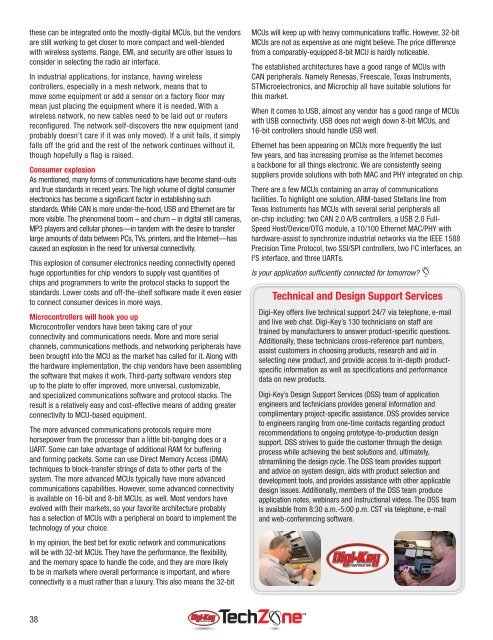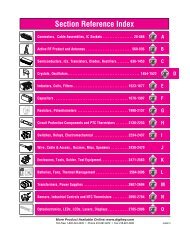Microcontroller Solutions TechZone Magazine, April 2011 - Digikey
Microcontroller Solutions TechZone Magazine, April 2011 - Digikey
Microcontroller Solutions TechZone Magazine, April 2011 - Digikey
Create successful ePaper yourself
Turn your PDF publications into a flip-book with our unique Google optimized e-Paper software.
these can be integrated onto the mostly-digital MCUs, but the vendors<br />
are still working to get closer to more compact and well-blended<br />
with wireless systems. Range, EMI, and security are other issues to<br />
consider in selecting the radio air interface.<br />
In industrial applications, for instance, having wireless<br />
controllers, especially in a mesh network, means that to<br />
move some equipment or add a sensor on a factory floor may<br />
mean just placing the equipment where it is needed. With a<br />
wireless network, no new cables need to be laid out or routers<br />
reconfigured. The network self-discovers the new equipment (and<br />
probably doesn’t care if it was only moved). If a unit fails, it simply<br />
falls off the grid and the rest of the network continues without it,<br />
though hopefully a flag is raised.<br />
Consumer explosion<br />
As mentioned, many forms of communications have become stand-outs<br />
and true standards in recent years. The high volume of digital consumer<br />
electronics has become a significant factor in establishing such<br />
standards. While CAN is more under-the-hood, USB and Ethernet are far<br />
more visible. The phenomenal boom – and churn – in digital still cameras,<br />
MP3 players and cellular phones—in tandem with the desire to transfer<br />
large amounts of data between PCs, TVs, printers, and the Internet—has<br />
caused an explosion in the need for universal connectivity.<br />
This explosion of consumer electronics needing connectivity opened<br />
huge opportunities for chip vendors to supply vast quantities of<br />
chips and programmers to write the protocol stacks to support the<br />
standards. Lower costs and off-the-shelf software made it even easier<br />
to connect consumer devices in more ways.<br />
<strong>Microcontroller</strong>s will hook you up<br />
<strong>Microcontroller</strong> vendors have been taking care of your<br />
connectivity and communications needs. More and more serial<br />
channels, communications methods, and networking peripherals have<br />
been brought into the MCU as the market has called for it. Along with<br />
the hardware implementation, the chip vendors have been assembling<br />
the software that makes it work. Third-party software vendors step<br />
up to the plate to offer improved, more universal, customizable,<br />
and specialized communications software and protocol stacks. The<br />
result is a relatively easy and cost-effective means of adding greater<br />
connectivity to MCU-based equipment.<br />
The more advanced communications protocols require more<br />
horsepower from the processor than a little bit-banging does or a<br />
UART. Some can take advantage of additional RAM for buffering<br />
and forming packets. Some can use Direct Memory Access (DMA)<br />
techniques to block-transfer strings of data to other parts of the<br />
system. The more advanced MCUs typically have more advanced<br />
communications capabilities. However, some advanced connectivity<br />
is available on 16-bit and 8-bit MCUs, as well. Most vendors have<br />
evolved with their markets, so your favorite architecture probably<br />
has a selection of MCUs with a peripheral on board to implement the<br />
technology of your choice.<br />
In my opinion, the best bet for exotic network and communications<br />
will be with 32-bit MCUs. They have the performance, the fl exibility,<br />
and the memory space to handle the code, and they are more likely<br />
to be in markets where overall performance is important, and where<br />
connectivity is a must rather than a luxury. This also means the 32-bit<br />
MCUs will keep up with heavy communications traffi c. However, 32-bit<br />
MCUs are not as expensive as one might believe. The price difference<br />
from a comparably-equipped 8-bit MCU is hardly noticeable.<br />
The established architectures have a good range of MCUs with<br />
CAN peripherals. Namely Renesas, Freescale, Texas Instruments,<br />
STMicroelectronics, and Microchip all have suitable solutions for<br />
this market.<br />
When it comes to USB, almost any vendor has a good range of MCUs<br />
with USB connectivity. USB does not weigh down 8-bit MCUs, and<br />
16-bit controllers should handle USB well.<br />
Ethernet has been appearing on MCUs more frequently the last<br />
few years, and has increasing promise as the Internet becomes<br />
a backbone for all things electronic. We are consistently seeing<br />
suppliers provide solutions with both MAC and PHY integrated on chip.<br />
There are a few MCUs containing an array of communications<br />
facilities. To highlight one solution, ARM-based Stellaris line from<br />
Texas Instruments has MCUs with several serial peripherals all<br />
on-chip including: two CAN 2.0 A/B controllers, a USB 2.0 Full-<br />
Speed Host/Device/OTG module, a 10/100 Ethernet MAC/PHY with<br />
hardware-assist to synchronize industrial networks via the IEEE 1588<br />
Precision Time Protocol, two SSI/SPI controllers, two I 2 C interfaces, an<br />
I 2 S interface, and three UARTs.<br />
Is your application suffi ciently connected for tomorrow<br />
Technical and Design Support Services<br />
Digi-Key offers live technical support 24/7 via telephone, e-mail<br />
and live web chat. Digi-Key’s 130 technicians on staff are<br />
trained by manufacturers to answer product-specifi c questions.<br />
Additionally, these technicians cross-reference part numbers,<br />
assist customers in choosing products, research and aid in<br />
selecting new product, and provide access to in-depth productspecifi<br />
c information as well as specifi cations and performance<br />
data on new products.<br />
Digi-Key’s Design Support Services (DSS) team of application<br />
engineers and technicians provides general information and<br />
complimentary project-specifi c assistance. DSS provides service<br />
to engineers ranging from one-time contacts regarding product<br />
recommendations to ongoing prototype-to-production design<br />
support. DSS strives to guide the customer through the design<br />
process while achieving the best solutions and, ultimately,<br />
streamlining the design cycle. The DSS team provides support<br />
and advice on system design, aids with product selection and<br />
development tools, and provides assistance with other applicable<br />
design issues. Additionally, members of the DSS team produce<br />
application notes, webinars and instructional videos. The DSS team<br />
is available from 8:30 a.m.-5:00 p.m. CST via telephone, e-mail<br />
and web-conferencing software.<br />
38














